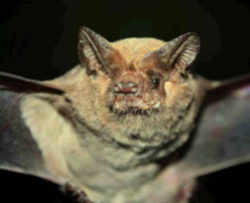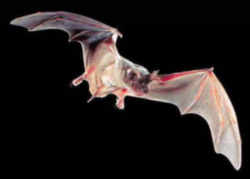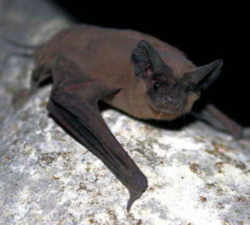
Oklahoma Symbols
Oklahoma State Flying Mammal
Mexican Free-tailed Bat

(Tadarida brasiliensis)
Adopted on November 1, 2006.
The Mexican free-tailed bat, (Tadarida brasiliensis,) is Oklahoma's Flying Mammal, adopted in 2006.
Oklahoma designated the Mexican free-tailed bat as the official state flying mammal in 2006. State Representative Jeff Hickman (one of the bill's sponsors) explained that the Mexican free-tailed bat flies to Oklahoma to breed and then flies back to its indigenous Mexico. He said, "Texas also has the Mexican free-tailed bat as its official flying mammal but the only thing it does in Texas is leave a few droppings on its way to Oklahoma."
A medium sized bat. Their bodies are about 9 centimeters in length, and they weigh about 15 grams. Their ears are wide and set apart to help them
find prey with echolocation. Its fur color varies from dark brown to gray.
Oklahoma State Flying Mammal
Mexican Free-tailed Bat

The Mexican free-tailed bat (Tadarida brasiliensis), also known as the Brazilian free-tailed bat and Austonian bridge bat, is a medium-sized bat that is native to the Americas and is widely regarded as one of the most abundant mammals in North America.
Mexican free-tailed bats are about 9 cm (3.5 in) in length, and they weigh about 12.3 g (0.43 oz). Their tails make up almost half their lengths. Their ears are wide and set apart to help them find prey with echolocation. They are also fairly close behind the snout and eyes. Their fur color varies from dark brown to gray. Their muzzles are condensed, with wrinkled upper lips. The tail of these bats stretches further than the uropatagium, hence they are named "free-tailed" bats. The wings are elongated and narrow with pointed tips, making them well-equipped for quick, straight flight patterns.
Characteristics of the Mexican free-tailed bat
Migration/Hibernation: Most of these bats migrate south to Central America and Mexico during the winter.
Habitat: Mexican free-tails prefer to roost in caves, but will also choose attics, under bridges, or in abandoned buildings. They choose roosts near water. The water attracts the insects they eat, as well as allowing them the opportunity to drink.
Range: Mexican free-tails are found in the western United States, south through Mexico, Central America and into northern South America.
Wild Status: These bats are not currently threatened or endangered.
Diet: Free-tail bats consume enormous amounts of moths and other insects. Some roosts are known to contain millions of bats. In those colonies it is estimated that 250 tons of insects can be consumed every night.
Predators: Snakes, raccoons, house cats, owls, and other predators sometimes manage to gain access to the roosts. If a baby falls to the cave floor the mother will not come to its rescue giving predators a chance for a quick meal.
Reproduction: A single free-tail baby bat is born during the summer. Young Mexican free-tailed bats roost separately from their mothers. Babies roost in the highest reaches of the cave, where temperatures are the warmest. The warm conditions are essential for rapid growth and survival. In the large maternity colonies of Mexican free-tails, the mother must find her own pup among the thousands. It is thought that she locates her baby by recognizing its individual call.
Life Span: These bats may have a life span of up to 18 years.
Size: Their weight is between 0.4-0.5 oz (11- 14 g) and their wingspan is between 12-14 in (30-35 cm).
Governor Signs Legislation Selecting Bat as State's Flying Mammal
Oklahoma State Senate
Communications Division
State Capitol
Oklahoma City, OK 73105
 The Governor has signed legislation naming
the Mexican free-tailed bat as the official state flying mammal of Oklahoma.
The Governor has signed legislation naming
the Mexican free-tailed bat as the official state flying mammal of Oklahoma.
The bat - unusual for its long, skinny tail and unique migratory pattern - has become a major tourist attraction for the Selman Bat Cave Wildlife Management
Area located in Freedom, Oklahoma, just west of Alabaster Caverns State Park.
Senator Owen Laughlin, author of Senate Bill 1678 recognizing the Mexican free-tailed bat as the state's official flying mammal, said the legislation
was authored to promote tourism.
"The Selman Bat Cave Wildlife Management Area is a special tourist attraction,"said Laughlin, R-Woodward. "Each summer, tourists from all
over the country visit the caves to observe the bats as they come to give birth and exit the cave for feeding at night. It really is a rare sight."
Approximately one million bats migrate to the caves, which serve as a maternity colony, each year. Only female bats and their offspring migrate to
the caves, making it an opportunity to observe particularly unusual behavioral patterns. At sundown, thousands of bats will ascend from the caves,
many with their offspring hanging from their bodies, in a massive spiraling cloud to feed on insects.
"This mammal is good for Oklahoma in that it brings tourist dollars to our state, provides a learning experience for observers, and helps cut down
on the mosquito population,"Laughlin said. "The bats will eat nearly 40 percent of their own body weight in mosquitos each night, which is
great for area landowners. I encourage all Oklahomans to make plans to visit Alabaster Caverns State Park and take a tour of the Selman Bat Cave."
Oklahoma Law
The law designating the Mexican free-tailed bat, as the official Oklahoma state flying mammal is found in the Oklahoma Statutes, Title 25, Chapter 3, Section 25-98.11
Title 25. Definitions and General Provisions
Chapter 3 - State Emblems and Honorary Positions
Section 98.11 - State Flying Mammal
Cite as: O.S. §25-98.11
The Mexican free-tailed bat, Tadarida brasiliensis, is hereby designated and adopted as the official state flying mammal of the State of Oklahoma.
Added by Laws 2006, c. 37, § 1, eff. Nov. 1, 2006.
Taxonomic Hierarchy: Mexican Free-tailed Bat
Kingdom: Animalia
Phylum: Chordata
Class: Mammalia
Order: Chiroptera
Family: Molossidae
Genus: Tadarida
Species: T. brasiliensis







